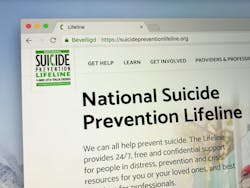According to a Dec. 20 press release, the Department of Health and Human Services (HHS), through its Substance Abuse and Mental Health Services Administration (SAMHSA), announced that it will make investments in suicide prevention and crisis care services. Currently, the National Suicide Prevention Lifeline has a 10-digit number. The organization will give $282 million to assist in the transition to a three-digit dialing code—988.
The release states that “In 2020, Congress designated the new 988 dialing code to be operated through the existing National Suicide Prevention Lifeline. Converting to this easy-to-remember, three-digit number will strengthen and expand the existing Lifeline network, providing the public with easier access to life-saving services. The Lifeline currently helps thousands of people overcome crisis situations every day. The 988 dialing code will be available nationally for call, text or chat beginning in July 2022.”
That said, “With funds from the Biden-Harris Administration’s Fiscal Year (FY) 2022 budget and additional funds from the American Rescue Plan, SAMHSA’s $282 million investment will support 988 efforts across the country to shore up, scale up and staff up, including:
- $177 million to strengthen and expand the existing Lifeline network operations and telephone infrastructure, including centralized chat/text response, backup center capacity, and special services (e.g., a sub-network for Spanish language-speakers).
- $105 million to build up staffing across states’ local crisis call centers.”
According to 2019 U.S. Centers for Disease Control and Prevention data, suicide is the second-leading cause of death for young people and the tenth-leading cause overall. That same year, one death by suicide occurred almost every 11 minutes in the U.S.
“More recently, SAMHSA’s 2020 National Survey on Drug Use and Health (NSDUH) data show 4.9 percent of adults aged 18 or older had serious thoughts of suicide, 1.3 percent made a suicide plan, and 0.5 percent attempted suicide in the past year,” the release continues. “Among adolescents 12 to 17, 12 percent had serious thoughts of suicide, 5.3 percent made a suicide plan, and 2.5 percent attempted suicide in the past year. The findings vary by race and ethnicity, with people of mixed ethnicity reporting higher rates of serious thoughts of suicide.”
HHS Secretary Xavier Becerra was quoted in the release saying that “As we continue to confront the impact of the pandemic, investing in this critical tool is key to protecting the health and wellbeing of countless Americans—and saving lives. Giving the states a tool to prevent suicide and support people in crisis is essential to our HHS mission of protecting the health and wellbeing of everyone in our nation. We know that remembering a three-digit number beats a ten-digit number any day, particularly in times of crisis, and I encourage every state to rev up planning to implement 988 for the sake of saving lives.”


